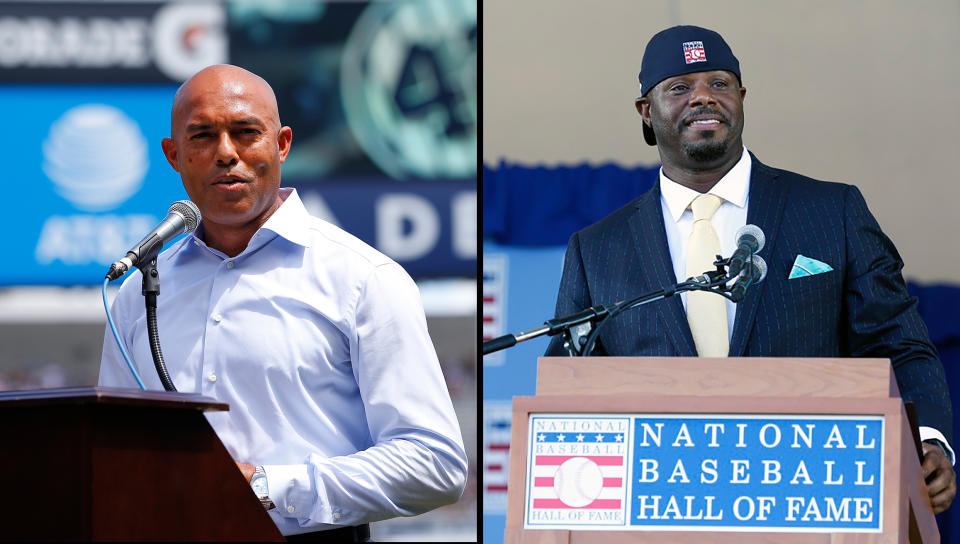Mariano Rivera could be the first unanimous Hall of Famer in baseball history
There are 226 former Major League Baseball players in the National Baseball Hall of Fame, and they all have one thing in common: Not a single one has arrived to Cooperstown as a unanimous selection.
Not Babe Ruth. Not Hank Aaron. Not Willie Mays. Not even Ted Williams or Stan Musial or Roberto Clemente. Despite their incredible production and the undeniable impact each of those iconic players had on baseball, none of them earned the full support of the Hall of Fame voters. In fact, none of the aforementioned legends are among the six players to top 98 percent when elected.
It’s a remarkable truth that speaks to how fickle, how dramatic, how disillusioned and, in some instances, how power hungry Hall of Fame voters can be. Now though, as the announcement of the 2019 class nears, it’s a remarkable truth that is facing its stiffest challenge. Mariano Rivera, the all-time saves leader in MLB history, is inching closer to rewriting this startling piece of history.
The New York Yankees legend enters the final weekend before the Hall of Fame announcement having been named on 100 percent of the 185 known ballots. His election has long been a foregone conclusion, but the drama is reaching a fever pitch as he aims to become the first-ever unanimously elected player to the National Baseball Hall of Fame.
The caveat, of course, is that we’ve only seen roughly 45 percent of the ballots so far. The result of the remaining 225 (or so) ballots won’t be known until the class is announced. History has taught us that these unknown ballots tend to bring the percentages down. Sometimes significantly enough that players with 80 percent going in still fall short of the 75 percent required for enshrinement.
Will Rivera be the unique case that maintains his strong support across the board, or will he join this short list of players so close to unanimous, but so far away.

Ken Griffey Jr. — 99.32 percent in 2016
The closest we’ve come to a unanimous Hall of Famer was Ken Griffey Jr. in 2016. The former Seattle Mariner, Cincinnati Red and Chicago White Sox outfielder was named on 437 of the 440 ballots that were cast.
Griffey, who was in his first year on the ballot, was one of two players (Mike Piazza, 83.0 percent) elected by the BBWAA that year. He managed that record percentage despite being on a loaded ballot that included future BBWAA Hall of Famers Tim Raines, Trevor Hoffman and Jeff Bagwell, and some top names that remain this year, including Barry Bonds, Roger Clemens and Curt Schilling.
Tom Seaver — 98.84 percent in 1992
Of the 77 pitchers in the National Baseball Hall of Fame, it’s Seaver who was closest to earning a unanimous selection. The 311-game winner was named on 425 of 430 ballots in 1992.
His case might also best explain how erratic the voting can be. In 2006, Hal Bodley of USA Today wrote of the odd nature in which the longtime New York Mets ace lost four votes.
There were few flaws in Seaver’s credentials, but still five voters didn’t think he was a first-ballot Hall of Famer.
Jeff Idelson, Hall of Fame vice president for communications and education, says technically Seaver should have missed perfection by just one vote.
“Three voters submitted blank ballots in protest of Pete Rose (for not being on the ballot),” Idelson says. “Another, following open-heart surgery, overlooked Seaver after filling out his ballot, and a fifth said he didn’t vote for first-time eligibles. Seaver should have missed by one, assuming four of the five would have voted for him.”
The lesson: Assumptions should never be made when it comes to Hall of Fame voting.

Nolan Ryan — 98.79 percent in 1999
George Brett — 98.19 percent in 1999
Two of the six players closest to unanimous selection came from the same Hall of Fame class. In 1999, Nolan Ryan received 491 of a then-record 497 votes, while George Brett received 488. At the time, that put both players in the top four for voting percentage.
The BBWAA class that year was rounded out by Robin Yount, who edged his way in with 77.4 percent. That made this the first class to include three first-year eligible Hall of Famers since the first election in 1936.
Cal Ripken Jr. — 98.53 percent in 2007
Not even baseball’s ironman could earn 100 percent of the vote.
Ripken fell eight short, earning 537 of the 545 votes turned in during the 2007 election. Tony Gwynn was pretty close behind with 532 votes. There shouldn’t be any kind of case for either player to not be included on a ballot. Yet Paul Ladewski of the Daily Southtown in suburban Chicago found one by lumping them together with players who were believed to have used performance-enhancing drugs in baseball.
“At this point, I don’t have nearly enough information to make a value judgment of this magnitude. In particular, that concerns any player in the Steroids Era, which I consider to be the 1993-2004 period, give or a take a season,” Ladewski wrote at the time, courtesy of the Washington Post.
“This isn’t to suggest that Gwynn or Ripken or the majority of the other eligible candidates padded his statistics with performance-enhancers and cheated the game, their predecessors and the fans in the process. … But tell me, except for the players themselves, who can say what they put into their bodies over the years with any degree of certainty?”
It’s tough to get every vote when some are willing to reach that far for a reason not to vote at all.
Ty Cobb — 98.23 percent in 1936
Of the five players elected to the National Baseball Hall of Fame’s first class, Cobb received the highest percentage of votes.
Cobb was named on 222 of 226 ballots, topping fellow first-class inductees Babe Ruth (215), Honus Wagner (215), Christy Mathewson (205) and Walter Johnson (189).
Needless to say, that will forever be the deepest Hall of Fame ballot ever. The writers were instructed to pick up to 10 players, which is the same limit that exists today. There were 226 ballots cast, with 170 votes required for election. That’s a shade over 75 percent.
Nap Lajoie, Tris Speaker, Cy Young and Rogers Hornsby were all left on the outside looking in.
Mickey Cochrane (80 votes), Lou Gehrig (51) and Jimmie Foxx (21) couldn’t even reach 100 votes. Considering the circumstances and the competition, Cobb’s high percentage might be the most impressive in Hall of Fame history.
If not Mariano Rivera, then who?
If Mariano Rivera ends up falling short of a unanimous vote, we won’t have to wait long for the next potential challenger. Yankees legend and current Miami Marlins owner Derek Jeter will join the ballot next season, and it’s difficult to imagine him not getting a huge swell of support from voters.
Jeter does have his share of detractors who are quick to point out where he fell short during his career. Others say he definitely belongs in, just not on the first ballot. That’s why we wouldn’t put money on a unanimous choice. At the very least, Jeter seems like a strong bet to top 95 percent.
If and when Ichiro Suzuki retires, then he might move to the front of this line. Among other current players, Los Angeles Dodgers pitcher Clayton Kershaw and Los Angeles Angels outfielder Mike Trout could have a shot. Of course, we’re a long ways away from any of those guys reaching the ballot.
More from Yahoo Sports:
• Turkey seeks arrest warrant for NBA star
• Atlanta mayor clarifies Saints Super Bowl remark
• The real reason for NFL playoff star’s weight gain
• Paylor: ‘Redshirt’ year big for Mahomes

